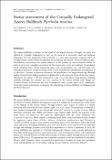Files in this item
Status assessment of the Critically Endangered Azores Bullfinch Pyrrhula murina
Item metadata
| dc.contributor.author | Ceia, Ricardo S. | |
| dc.contributor.author | Ramos, Jaime A. | |
| dc.contributor.author | Heleno, Ruben H. | |
| dc.contributor.author | Hilton, Geoff M. | |
| dc.contributor.author | Marques, Tiago A. | |
| dc.date.accessioned | 2012-04-10T23:40:06Z | |
| dc.date.available | 2012-04-10T23:40:06Z | |
| dc.date.issued | 2011 | |
| dc.identifier | 6640393 | |
| dc.identifier | cbcfe1f9-ef9f-454b-ab39-e7ed61ee2c3f | |
| dc.identifier | 80855144197 | |
| dc.identifier.citation | Ceia , R S , Ramos , J A , Heleno , R H , Hilton , G M & Marques , T A 2011 , ' Status assessment of the Critically Endangered Azores Bullfinch Pyrrhula murina ' , Bird Conservation International , vol. 21 , no. 4 , pp. 477-489 . https://doi.org/10.1017/S0959270911000025 | en |
| dc.identifier.issn | 0959-2709 | |
| dc.identifier.other | Bibtex: urn:2fc9389ca026a100d93f63586ad94b7e | |
| dc.identifier.other | ORCID: /0000-0002-2581-1972/work/56861251 | |
| dc.identifier.uri | https://hdl.handle.net/10023/2552 | |
| dc.description | 'This work was part of the Azores Bullfinch monitoring programme included in the project LIFE NAT/P/000013 “Recovery of Azores Bullfinch’s habitat in the Special Protection Area of Pico da Vara / Ribeira do Guilherme”' | en |
| dc.description.abstract | The Azores Bullfinch is endemic to the island of São Miguel (Azores, Portugal). Its status was uplisted to Critically Endangered in 2005 on the basis of an extremely small and declining population that was considered to be restricted to a very small mountain range (43 km2), in a single location, within which the spread of invasive plants constituted a threat to habitat quality. Nevertheless, information was mostly inferred, or the product of, non-systematic studies. In order to carry out a complete assessment of the conservation status we analysed: (i) population trend, calculated from annual monitoring 1991–2008, (ii) population size, and (iii) range size, obtaining estimates in a single morning study in 2008 involving the simultaneous participation of 48 observers. Contrary to previous inferences, the population is no longer decreasing, although quality of laurel forest habitat continues to decline due to the persistent threat of invasive species. Population size (mean ± SE) was estimated at 1,064 ± 304 individuals using distance sampling methods, although the estimate was very sensitive to the survey method used. Range size estimates (extent of occurrence and area of occupancy) were 144 km2 and 83 km2 respectively. Given the present information, we propose the downlisting of Azores Bullfinch to Endangered on the IUCN Red List. | |
| dc.format.extent | 13 | |
| dc.format.extent | 301097 | |
| dc.language.iso | eng | |
| dc.relation.ispartof | Bird Conservation International | en |
| dc.subject | QL Zoology | en |
| dc.subject.lcc | QL | en |
| dc.title | Status assessment of the Critically Endangered Azores Bullfinch Pyrrhula murina | en |
| dc.type | Journal article | en |
| dc.contributor.institution | University of St Andrews. School of Mathematics and Statistics | en |
| dc.contributor.institution | University of St Andrews. Scottish Oceans Institute | en |
| dc.contributor.institution | University of St Andrews. Centre for Research into Ecological & Environmental Modelling | en |
| dc.identifier.doi | 10.1017/S0959270911000025 | |
| dc.description.status | Peer reviewed | en |
| dc.date.embargoedUntil | 2012-04-11 |
This item appears in the following Collection(s)
Items in the St Andrews Research Repository are protected by copyright, with all rights reserved, unless otherwise indicated.

